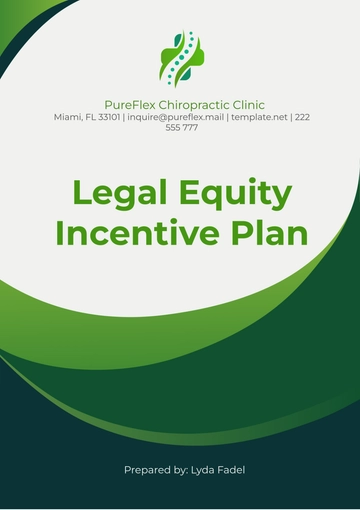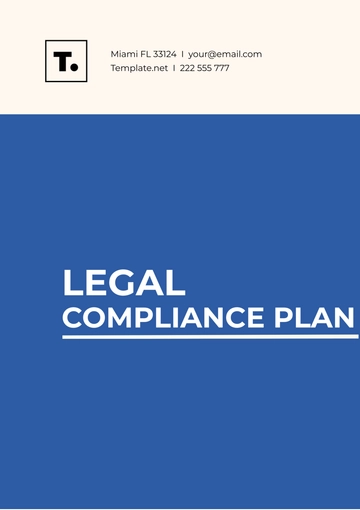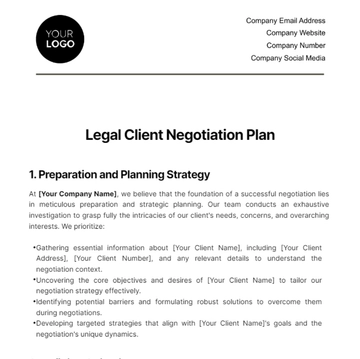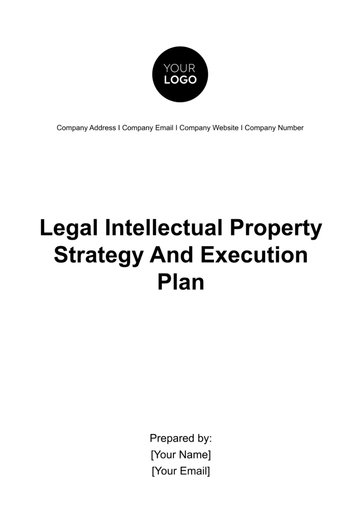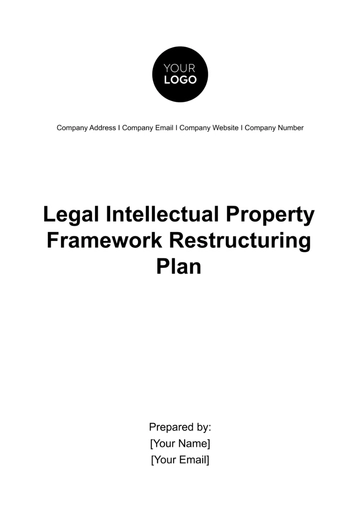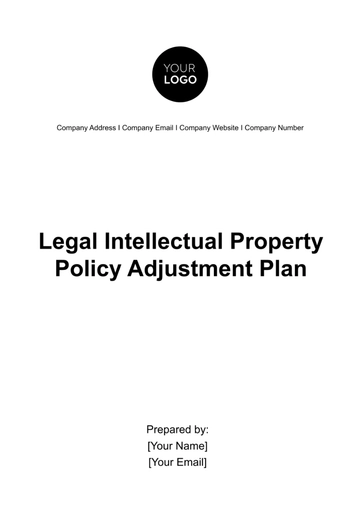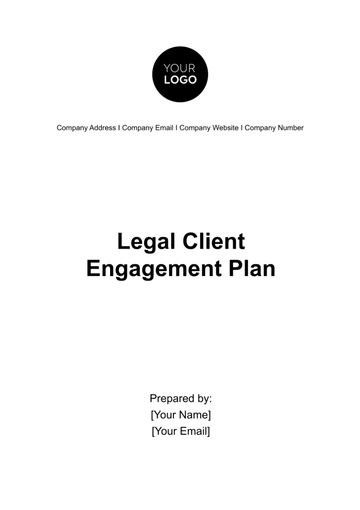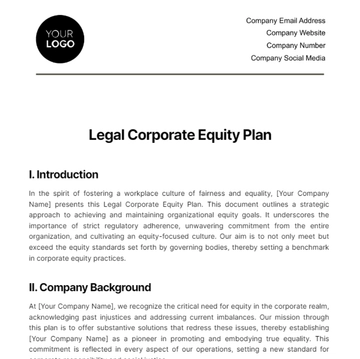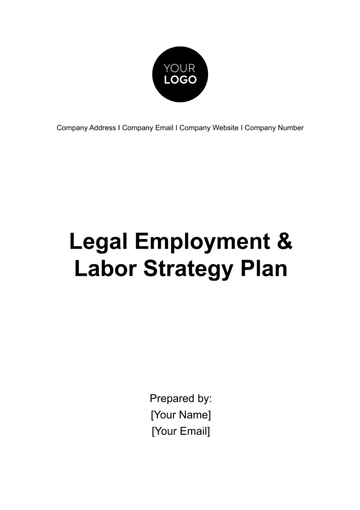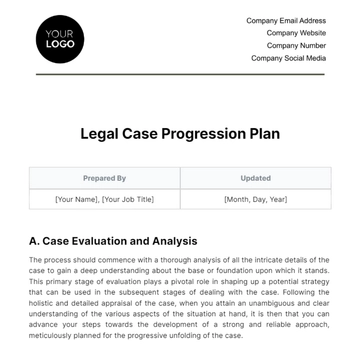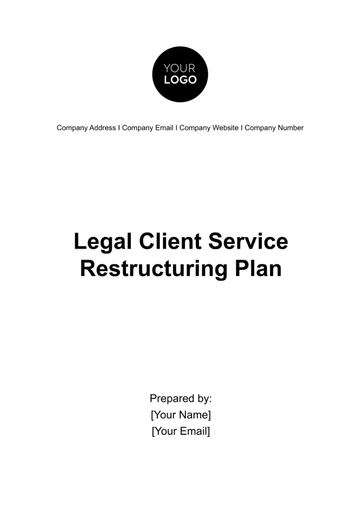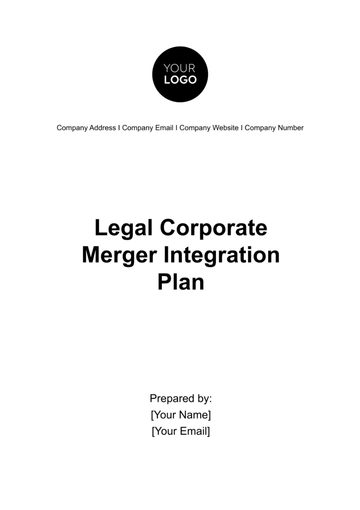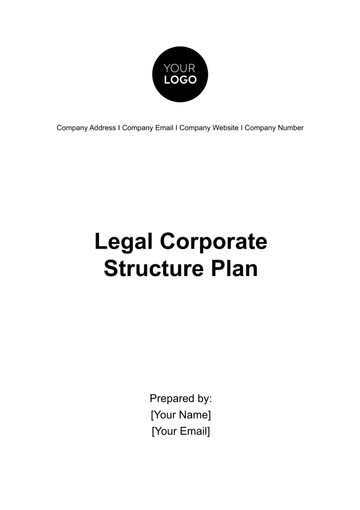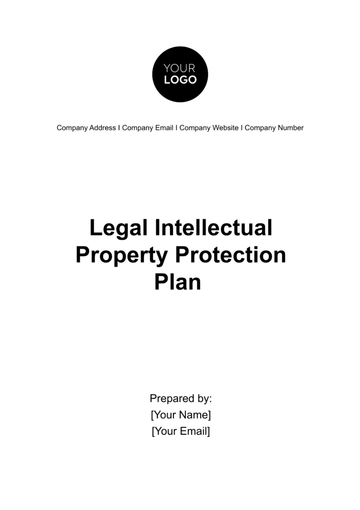Free Legal Client Negotiation Plan
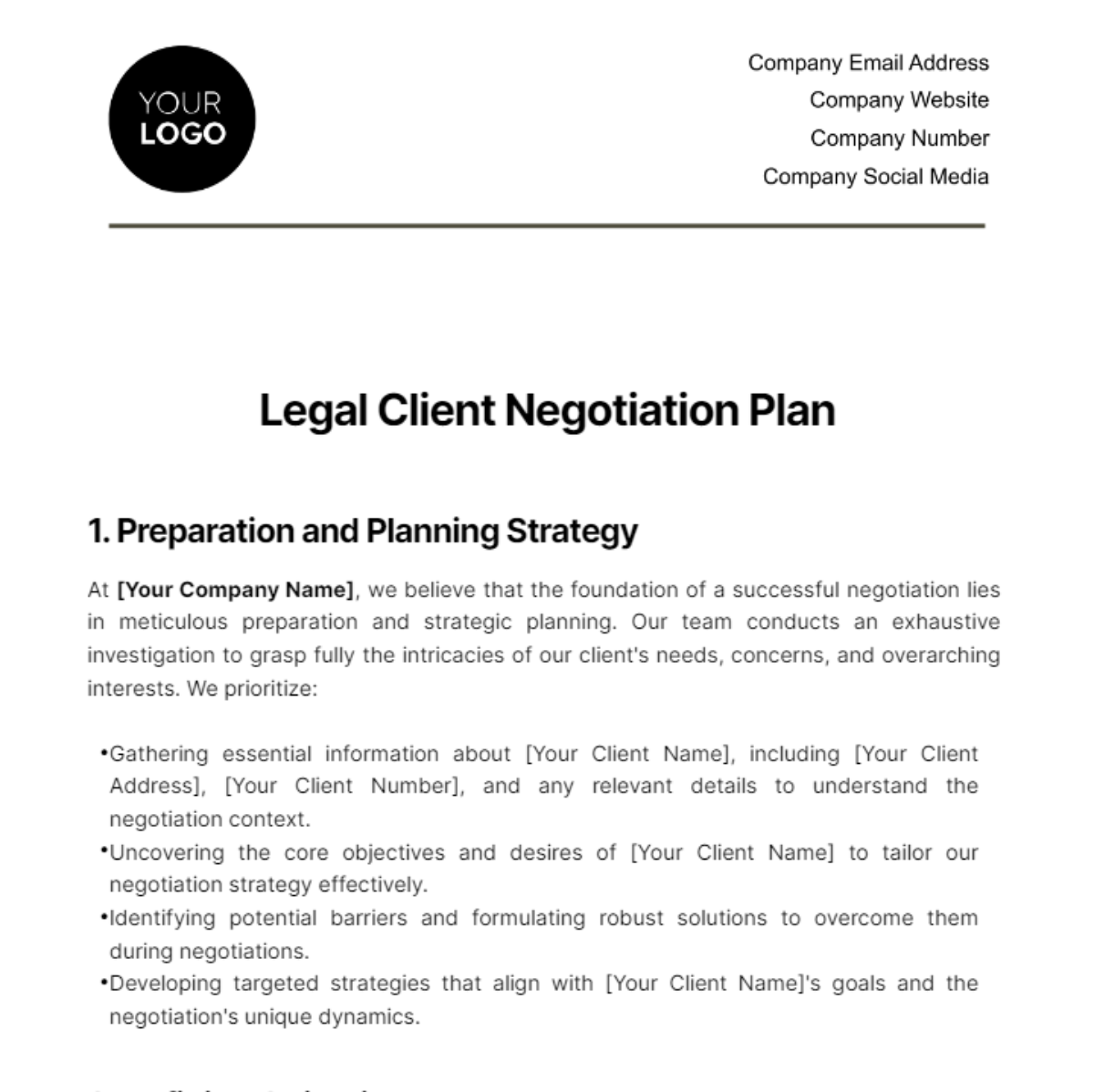
1. Preparation and Planning Strategy
At [Your Company Name], we believe that the foundation of a successful negotiation lies in meticulous preparation and strategic planning. Our team conducts an exhaustive investigation to grasp fully the intricacies of our client's needs, concerns, and overarching interests. We prioritize:
Gathering essential information about [Your Client Name], including [Your Client Address], [Your Client Number], and any relevant details to understand the negotiation context.
Uncovering the core objectives and desires of [Your Client Name] to tailor our negotiation strategy effectively.
Identifying potential barriers and formulating robust solutions to overcome them during negotiations.
Developing targeted strategies that align with [Your Client Name]'s goals and the negotiation's unique dynamics.
2. Defining Objectives
[Your Company Name] commits to delineating clear, achievable targets that are pivotal in guiding the negotiation towards a fruitful resolution. This step is instrumental in harmonizing our strategic intentions with [Your Client Name]'s aspirations, ensuring a pathway is laid out that is both ambitious and grounded in feasibility. By setting these benchmarks, we not only align our efforts towards a common goal but also establish a framework within which success can be measured and evaluated.
A. Establishing Clear Goals
We initiate this phase by collaboratively establishing clear, specific goals with [Your Client Name], ensuring each objective is aligned with their long-term vision and immediate needs. This collaborative approach guarantees that the goals set are not only realistic but also mutually beneficial, fostering a sense of partnership and shared ambition.
B. Measuring Success
In setting measurable objectives, [Your Company Name] introduces quantifiable benchmarks that serve as indicators of progress throughout the negotiation process. These metrics provide both parties with a clear understanding of what success looks like, enabling adjustments and strategic shifts to be made with precision and purpose.
C. Aligning with Realities
Understanding the negotiation landscape's realities is paramount. [Your Company Name] meticulously evaluates all factors that could impact the negotiation, including legal constraints, market conditions, and [Your Client Name]'s operational capabilities. This holistic view ensures that the objectives set are not only aspirational but also achievable, grounded firmly in the context of the current environment and future projections.
Through this comprehensive approach to defining objectives, [Your Company Name] lays the groundwork for negotiations that are structured, focused, and primed for success. By establishing clear, measurable, and realistic goals, we pave the way for outcomes that are both beneficial and attainable, reflecting a deep understanding of [Your Client Name]'s needs and the broader negotiation context.
3. Communication Tactics
Effective communication is the cornerstone of successful negotiations. At [Your Company Name], we prioritize clear, concise, and adaptable communication tactics that resonate with [Your Client Name]'s style and preferences. Our approach is designed to ensure mutual understanding and to build a strong rapport with [Your Client Name], leveraging both verbal and nonverbal cues to foster a collaborative and productive negotiation environment.
A. Communication Tactics Overview
Tactic | Description | Purpose |
|---|---|---|
Clear Expression of Demands | Articulating our objectives and expectations in a straightforward manner. | To ensure that [Your Client Name] fully understands our position and goals. |
Attentive Listening | Actively listening to [Your Client Name]'s responses, feedback, and needs. | To demonstrate respect for [Your Client Name]'s perspectives and to tailor our approach accordingly. |
Adaptive Communication Style | Modifying our communication approach to align with [Your Client Name]'s preferred style. | To enhance rapport and foster a comfortable dialogue environment. |
Utilization of Nonverbal Cues | Observing and responding to [Your Client Name]'s nonverbal signals. | To gain insights into [Your Client Name]'s unspoken concerns or agreements, enhancing our understanding and responsiveness. |
Through these strategic communication tactics, [Your Company Name] aims to establish a negotiation environment where both parties feel heard, understood, and valued. By focusing on clear expression, attentive listening, adaptive communication, and the utilization of nonverbal cues, we set the stage for a negotiation process that is not only efficient and effective but also conducive to building a lasting relationship with [Your Client Name].
4. Trust and Relationship Building
At [Your Company Name], we understand the immense value of fostering trust and cultivating strong relationships with [Your Client Name]. Our approach is rooted in professionalism, transparency, and unwavering ethical standards, setting the stage for a negotiation environment where open, honest dialogue flourishes. We are dedicated to not just achieving short-term goals but also to laying the groundwork for a partnership that endures well into the future. By prioritizing trust and relationship building, we ensure a collaborative and mutually beneficial negotiation process.
A. Professionalism and Integrity
Our team embodies the highest standards of professionalism and integrity at every interaction. We commit to consistent, respectful, and ethical behavior, ensuring [Your Client Name] feels valued and respected throughout the negotiation process. This commitment lays the foundation for trust and demonstrates our dedication to a principled negotiation approach.
B. Transparency in Communication
Transparency is key to building trust. [Your Company Name] ensures that all communication with [Your Client Name] is clear, honest, and straightforward. By openly sharing information, intentions, and expectations, we eliminate uncertainties and foster an atmosphere of mutual respect and understanding, essential for effective collaboration and long-term relationship building.
C. Ethical Conduct
Our ethical conduct is non-negotiable. [Your Company Name] adheres to the highest ethical standards, ensuring that all negotiations and interactions with [Your Client Name] are conducted fairly, responsibly, and with the utmost respect for all parties involved. This commitment to ethics not only builds trust but also reinforces our reputation as a reliable and honorable partner in all our business dealings.
By prioritizing these principles, [Your Company Name] is not just focused on the immediate negotiation outcomes but is also deeply invested in developing a robust, trusting relationship with [Your Client Name]. We believe that a foundation built on professionalism, transparency, and ethical conduct is essential for successful negotiations and the creation of lasting partnerships.
5. Negotiation Techniques
[Your Company Name] employs a wide array of sophisticated negotiation techniques tailored to the unique dynamics of each discussion with [Your Client Name]. Our strategy encompasses everything from active listening and persuasive speaking to the deployment of advanced negotiation gambits and effective conflict resolution methods. This versatility allows us to navigate the negotiation landscape adeptly, ensuring outcomes that are not only beneficial to both parties but also foster a spirit of cooperation and mutual respect.
A. Active Listening
Active listening stands at the core of our negotiation technique arsenal. By fully engaging with and understanding [Your Client Name]'s perspectives, we can identify underlying needs and concerns, opening the door to more creative and agreeable solutions. This technique reinforces our commitment to valuing [Your Client Name]'s input, fostering a collaborative negotiation environment.
B. Persuasive Speaking
Our team is skilled in the art of persuasive speaking, employing well-crafted arguments that resonate with [Your Client Name]'s interests and values. This approach is designed to articulate the benefits of our proposals compellingly, ensuring that [Your Client Name] can see the value and logic in our position. Persuasive speaking is a critical tool in guiding negotiations towards mutually beneficial agreements.
C. Strategic Negotiation Gambits
[Your Company Name] utilizes strategic negotiation gambits tailored to the specific context of our discussions with [Your Client Name]. These tactics, ranging from the "anchoring" effect to "highball/lowball" techniques, are chosen carefully to advance the negotiation in a direction that is advantageous for both parties. Employing these gambits allows us to navigate complex negotiation scenarios effectively, ensuring a productive outcome.
D. Conflict Resolution Methods
Conflict is an inevitable aspect of negotiations, but [Your Company Name] is equipped with a variety of conflict resolution methods to address and overcome such challenges. Whether through mediation, seeking common ground, or employing problem-solving strategies, we aim to resolve disputes in a manner that respects [Your Client Name]'s needs while still advancing towards our negotiation objectives.
By integrating these techniques into our negotiation approach, [Your Company Name] ensures a dynamic and flexible strategy that can adapt to the nuances of each negotiation. Our focus on active listening, persuasive speaking, strategic gambits, and conflict resolution underscores our commitment to achieving outcomes that are not only mutually beneficial but also conducive to building a strong, lasting relationship with [Your Client Name].
6. Conflict Resolution Strategies
At [Your Company Name], we recognize that conflicts are sometimes inevitable in the negotiation process. However, we are equipped with a comprehensive suite of conflict resolution strategies to ensure that any disagreement is addressed promptly and effectively, maintaining the negotiation's momentum towards meeting [Your Client Name]'s objectives. Our preparedness to deploy mediation, arbitration, or the involvement of a neutral third party demonstrates our commitment to a resolution that respects the interests and goals of all parties involved.
A. Mediation
Mediation is a cornerstone of our conflict resolution approach. By facilitating dialogue between [Your Company Name] and [Your Client Name], we seek to uncover the root causes of disagreements and explore mutually acceptable solutions. This process is guided by a mediator who helps both parties reach a consensus without imposing a decision, ensuring that the resolution is collaborative and preserves the relationship.
B. Arbitration
When disputes require a more formal resolution mechanism, arbitration serves as a viable alternative. This method involves presenting the conflict to an arbitrator or a panel, who then makes a binding decision based on the merits of the case. [Your Company Name] approaches arbitration with a focus on fairness, aiming to ensure that the outcome is just and aligns with [Your Client Name]'s best interests.
C. Engaging a Neutral Third Party
In certain situations, bringing in a neutral third party can provide an objective perspective that helps unlock stalemates. This approach is particularly valuable when negotiations are highly complex or emotionally charged. By relying on the impartial insights of a third party, [Your Company Name] and [Your Client Name] can move beyond impasses and find pathways to agreement that might not have been apparent from the inside.
Our adeptness at navigating conflict through these strategies underscores [Your Company Name]'s dedication to achieving [Your Client Name]'s goals, even in the face of challenges. We prioritize maintaining the integrity of the negotiation process and the relationship between [Your Company Name] and [Your Client Name], ensuring that every dispute is an opportunity for growth and deeper understanding, rather than an obstacle.
7. Making and Receiving Proposals
In the negotiation journey, [Your Company Name] places immense value on the meticulous crafting and strategic evaluation of proposals. This phase is pivotal, as it involves the concrete expression of [Your Client Name]'s needs and our responses to them. We ensure that every proposal put forth is a reflection of the negotiation's predefined objectives, articulated in a manner that is both transparent and persuasive to [Your Client Name]. Our approach facilitates an open and constructive exchange, fostering an environment where ideas can be freely shared and refined.
A. Proposal Development
Our proposal development process is rigorous and tailored, focusing on aligning each proposal with the strategic goals of both [Your Company Name] and [Your Client Name]. We employ a detailed analysis to ensure that proposals are not only feasible but also advantageous for [Your Client Name], addressing their core needs and concerns while also considering the broader implications of the negotiation.
Step | Description | Action Items | Responsible Party |
|---|---|---|---|
1. Identify Needs | Understand the core needs and concerns of [Your Client Name]. | - Conduct meetings with [Your Client Name]. - Review previous agreements and discussions. | [Your Company Name] Team |
2. Analyze Objectives | Align the proposal with the strategic goals of both parties. | - Perform a SWOT analysis. - Define negotiation objectives. | Strategy Department |
3. Draft Proposal | Create a tailored proposal addressing [Your Client Name]'s needs. | - Draft proposal document. - Review legal and financial implications. | Legal and Finance Teams |
4. Internal Review | Conduct an internal review to ensure feasibility and advantage. | - Internal presentation. - Feedback collection and incorporation. | Review Committee |
B. Proposal Presentation
The manner in which proposals are presented to [Your Client Name] is carefully crafted to be clear and engaging, ensuring that the value and benefits of the proposal are immediately apparent. [Your Company Name] utilizes a variety of presentation techniques, including visual aids and demonstrations, to make a compelling case for our propositions, aiming to resonate with [Your Client Name]'s interests and priorities.
Step | Description | Action Items | Responsible Party |
|---|---|---|---|
1. Prepare Presentation | Develop clear and engaging presentation materials. | - Create visual aids and demonstrations. - Rehearse presentation. | Marketing and Sales Teams |
2. Present to [Your Client Name] | Convey the value and benefits of the proposal effectively. | - Schedule presentation meeting. - Deliver presentation, highlighting key benefits. | Sales Team Lead |
3. Address Queries | Respond to any questions or concerns from [Your Client Name]. | - Prepare Q&A session. - Provide detailed answers and clarifications. | Subject Matter Experts |
C. Proposal Evaluation
Upon receiving proposals from [Your Client Name], [Your Company Name] undertakes a thorough evaluation process. This involves analyzing the proposal's alignment with the negotiation objectives, its feasibility, and its potential impact on the ongoing relationship. We engage in a dialogue with [Your Client Name] to clarify any aspects of the proposal, seeking adjustments if necessary to ensure that the final agreement is mutually beneficial.
Through these steps, [Your Company Name] not only demonstrates its commitment to achieving the best possible outcomes for [Your Client Name] but also underscores the importance of a collaborative approach to negotiation. By making and receiving proposals in a manner that is both strategic and respectful, we lay the groundwork for agreements that are robust, fair, and forward-looking.
Step | Description | Action Items | Responsible Party |
|---|---|---|---|
1. Receive Proposal | Obtain and document proposals from [Your Client Name]. | - Collect proposal documents. - Organize for review. | Procurement Team |
2. Evaluate Proposal | Analyze alignment with objectives, feasibility, and impact. | - Perform a detailed analysis of the proposal. - Assess alignment with predefined objectives. | Evaluation Committee |
3. Negotiate Adjustments | Engage in dialogue for any necessary adjustments. | - Identify areas for negotiation. - Conduct negotiation sessions. | Negotiation Team |
4. Finalize Agreement | Conclude on a mutually beneficial agreement. | - Draft final agreement. - Obtain approvals and signatures. | Legal Department |
8. Bargaining Process
[Your Company Name] approaches bargaining with a focus on balance—understanding [Your Client Name]'s needs while firmly advocating for our set objectives. We strive for win-win outcomes, maintaining mutual respect and keeping the overarching goals in clear view.
9. Closing Agreement
Achieving a closed agreement marks the culmination of successful negotiations. [Your Company Name] drafts formal agreements that accurately capture the settlement details, ensuring both parties are clear on the terms and responsibilities defined within. This document serves as a vital reference for executing agreed-upon tasks and safeguarding against future disputes.
10. Post-Negotiation Analysis
Following the conclusion of negotiations, [Your Company Name] conducts a thorough analysis of the process. This review helps identify successful strategies and areas for improvement, equipping our team with enhanced insights for future negotiations with [Your Client Name] or other parties.
Prepared by:
[Your Name]
[Your Job Title]
[Your Company Name]
- 100% Customizable, free editor
- Access 1 Million+ Templates, photo’s & graphics
- Download or share as a template
- Click and replace photos, graphics, text, backgrounds
- Resize, crop, AI write & more
- Access advanced editor
Hit your negotiation goals with the Legal Client Negotiation Plan Template from Template.net. This editable and customizable plan, editable in our Ai Editor Tool, streamlines your preparation for effective client negotiation. Impress clients with your organized approach and clear strategy. Upscale your negotiation technique with our tool and let it become your secret to winning more deals.
You may also like
- Finance Plan
- Construction Plan
- Sales Plan
- Development Plan
- Career Plan
- Budget Plan
- HR Plan
- Education Plan
- Transition Plan
- Work Plan
- Training Plan
- Communication Plan
- Operation Plan
- Health And Safety Plan
- Strategy Plan
- Professional Development Plan
- Advertising Plan
- Risk Management Plan
- Restaurant Plan
- School Plan
- Nursing Home Patient Care Plan
- Nursing Care Plan
- Plan Event
- Startup Plan
- Social Media Plan
- Staffing Plan
- Annual Plan
- Content Plan
- Payment Plan
- Implementation Plan
- Hotel Plan
- Workout Plan
- Accounting Plan
- Campaign Plan
- Essay Plan
- 30 60 90 Day Plan
- Research Plan
- Recruitment Plan
- 90 Day Plan
- Quarterly Plan
- Emergency Plan
- 5 Year Plan
- Gym Plan
- Personal Plan
- IT and Software Plan
- Treatment Plan
- Real Estate Plan
- Law Firm Plan
- Healthcare Plan
- Improvement Plan
- Media Plan
- 5 Year Business Plan
- Learning Plan
- Marketing Campaign Plan
- Travel Agency Plan
- Cleaning Services Plan
- Interior Design Plan
- Performance Plan
- PR Plan
- Birth Plan
- Life Plan
- SEO Plan
- Disaster Recovery Plan
- Continuity Plan
- Launch Plan
- Legal Plan
- Behavior Plan
- Performance Improvement Plan
- Salon Plan
- Security Plan
- Security Management Plan
- Employee Development Plan
- Quality Plan
- Service Improvement Plan
- Growth Plan
- Incident Response Plan
- Basketball Plan
- Emergency Action Plan
- Product Launch Plan
- Spa Plan
- Employee Training Plan
- Data Analysis Plan
- Employee Action Plan
- Territory Plan
- Audit Plan
- Classroom Plan
- Activity Plan
- Parenting Plan
- Care Plan
- Project Execution Plan
- Exercise Plan
- Internship Plan
- Software Development Plan
- Continuous Improvement Plan
- Leave Plan
- 90 Day Sales Plan
- Advertising Agency Plan
- Employee Transition Plan
- Smart Action Plan
- Workplace Safety Plan
- Behavior Change Plan
- Contingency Plan
- Continuity of Operations Plan
- Health Plan
- Quality Control Plan
- Self Plan
- Sports Development Plan
- Change Management Plan
- Ecommerce Plan
- Personal Financial Plan
- Process Improvement Plan
- 30-60-90 Day Sales Plan
- Crisis Management Plan
- Engagement Plan
- Execution Plan
- Pandemic Plan
- Quality Assurance Plan
- Service Continuity Plan
- Agile Project Plan
- Fundraising Plan
- Job Transition Plan
- Asset Maintenance Plan
- Maintenance Plan
- Software Test Plan
- Staff Training and Development Plan
- 3 Year Plan
- Brand Activation Plan
- Release Plan
- Resource Plan
- Risk Mitigation Plan
- Teacher Plan
- 30 60 90 Day Plan for New Manager
- Food Safety Plan
- Food Truck Plan
- Hiring Plan
- Quality Management Plan
- Wellness Plan
- Behavior Intervention Plan
- Bonus Plan
- Investment Plan
- Maternity Leave Plan
- Pandemic Response Plan
- Succession Planning
- Coaching Plan
- Configuration Management Plan
- Remote Work Plan
- Self Care Plan
- Teaching Plan
- 100-Day Plan
- HACCP Plan
- Student Plan
- Sustainability Plan
- 30 60 90 Day Plan for Interview
- Access Plan
- Site Specific Safety Plan
